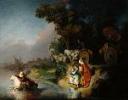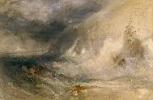
The lessons in the Stories in Art Curriculum explore works of art that depict narrative-inspired art. Lessons in this interdisciplinary curriculum engage students in topics in the disciplines of visual art, language arts, and/or history–social science.
Beginning-level activities address elementary school standards, intermediate activities address middle school standards, and advanced activities address high school standards. However, middle and high school teachers can use less advanced activities in warm-up discussions or to review basic principles.
|
 |
|
 |
 |
Lessons 1–6 of 6 |
 |
 |
 |
 |
 |

  |
 |
A Continuous Story in Art
Grades/Level: Lower Elementary (K–2), Upper Elementary (3–5)
Subjects: Visual Arts, English—Language Arts
Lesson Overview: Students will focus on how one artist tells the story of Joseph using continuous narrative. By observing and discussing visual details such as color and movement found in the painting, students write about what they think is happening. Students are encouraged to use the actions they observed in the painting to create and write a new story with a new character, and then illustrate them in their own continuous narrative.
|
 |
 |
 |
What's the Story?
Grades/Level: Lower Elementary (K–2), Upper Elementary (3–5)
Subjects: Visual Arts, English—Language Arts
Lesson Overview: Students will observe how artists used continuous and sequential narratives in three different works of art. They will focus on color, and then choose whether they want to illustrate one main character in a continuous narrative in a landscape setting or an architectural setting, or in a sequential narrative (similar to a comic strip). Students will then illustrate their narrative story and later write the story.
|
 |
 |
 |
Painting Europa
Grades/Level: Middle School (6–8)
Subjects: Visual Arts, English—Language Arts
Lesson Overview: Students focus on the Roman mythological story of the abduction of Europa. They compare and contrast how two artists depicted this story. Students are then introduced to the elements of foreshadowing and climax in literature, and how, through the use of color and emphasis, artists use these same elements in painting. Students write responses to the two paintings based on their observations related to foreshadowing and climax. Finally, they read an excerpt from the myth and discuss which part of the story each artist chose to illustrate.
|
 |
 |
 |
Dramatizing Europa
Grades/Level: Middle School (6–8)
Subjects: Visual Arts, English—Language Arts
Lesson Overview: Students will observe the painting The Abduction of Europa by Rembrandt Harmensz. Van Rijn. They will then form groups to create a tableau vivant (living picture) inspired by Rembrandt's The Abduction of Europa. Students will choose a character in the painting and create a scenario about what they think happened and what the character said before and after the scene. Each group will then collaborate and perform their tableau vivant for the class.
|
 |
 |
 |
Historical Narratives: Painting Romanticism
Grades/Level: High School (9–12)
Subjects: Visual Arts, English—Language Arts
Lesson Overview: Students will focus on the life and times of the artist Joseph Mallord William Turner. They will also discuss the historical narrative that Turner depicted in his painting Van Tromp, Going About to Please His Masters. Students then explore how the Romantic Movement influenced both literature and painting in the 18th and 19th centuries.
|
 |
 |
 |
Historical Narratives: Picturesque Views
Grades/Level: High School (9–12)
Subjects: Visual Arts
Lesson Overview: Students will observe a watercolor painting that depicts a view of a landmark in a dramatic setting—Longships Lighthouse, Land’s End by artist Joseph Mallord William Turner. Then they will experiment with a variety of techniques to create a dramatic setting, such as the scene depicted in Turner's historical narrative watercolor painting. Students will then create their own watercolor of an accident at a landmark using various watercolor techniques.
|
 |
 |
 |
 |
 |
 |
Lessons 1–6 of 6 |
 |
 |
 |
 |
 |

  |
 |





